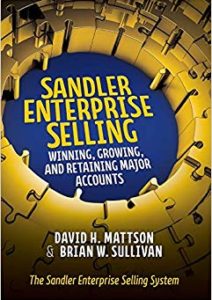Anna Lindh was a Swedish politician who was known for her fierce commitment to international cooperation. This famous quote of hers very aptly sums up today’s maelstrom of global trade, tariffs and supply chains – “Globalization has made us more vulnerable. It has created a world without borders and makes us painfully aware of the limitations of our present instruments and of politics to meet its challenges”. While she died in 2003, Ms. Lindh deserves great credit for her foresight in looking ahead to the world of global competition we live in today.
The politics of global competition aside, as salespeople, we can’t afford to dwell on its ever-changing news stories. We can’t take our eyes off the ball of our day-to-day responsibilities. Our sales managers and our quotas won’t allow it. We must stay focused on our local competitive challenges and what we need to do to overcome them. One of my favorite quotes is “In the dark of the night, every cat’s a leopard”. This unattributed Indian saying provides keen insight into selling and the need to understand the competitors who come prepared to face off against us daily. Our job is to analyze them and account for them. But what is available to help us do that today?
Competitive analysis typically comes in one of two flavors. First, there’s the competitive outlook often found in business planning to prove an initiative’s viability. It’s interesting but overly general and not helpful regarding a specific competitor in a deal. The other form involves extensive investigation and loads of data, producing a deep and wide view but also lacking the focus needed for specific situations. And even if you had the time, energy and resources for such deep dives, much of what you discover would simply be unnecessary documentation.
So, what can you do? How can you turn on the lights to see if the cat in the dark is a killer leopard or a cuddly Siamese?
As salespeople, we love frameworks, don’t we? So, of course, you start with a practical framework that I’ve often shared to help identify and understand the ten most important focus areas regarding competitors that you face every day:
- Facts
- Products/Services
- Performance
- Markets
- People
- Positioning
- Value Proposition/Pricing
- Accounts
- Strengths/Weaknesses
- Plans
Working with this framework, you target only the information that is particularly relevant to a specific competitor in a specific deal. Information that is, simply put, impactful. In selling, you must be laser-focused. The mountains of data that are publicly available can be distractions and sales teams can’t afford to spend their time learning details that are not squarely on the critical path to winning a deal. Nothing more, nothing less.
As an example, let’s consider the “People” section in the framework. In many competitive analysis templates, data-driven directives propose analysis of competitive organization charts and the firm’s top executives. If those high-level executives are specifically relevant to your particular deal and will have a direct impact on the outcome, then by all means, target your research on them. But it’s more likely that others in the competitive firm will be more important. Perhaps the competitive sales rep you’re facing off against or their industry expert with credible experience in the prospect account’s vertical market. If these individuals are specifically relevant in the deal, then your ability to strategize against them is critical and may well dictate the outcome. And remember – only you and your colleagues know who is most relevant and likely most impactful. Identify them and work to understand them. But don’t work to understand those targeted as important by some boilerplate competitive analysis template. And that same mindset regarding the practical value of information applies to the other areas of the framework as well.
Think about it. How helpful would it be to have a focused understanding of your key competitors in a specific deal? Nothing extraneous, only what’s truly impactful, streamlined and targeted to increase your chances of winning.
The ten areas in the framework cover a wide area allowing most competitive topics to be covered. In specific deals, some areas will be less relevant than others. Give them less or no focus, keeping your frame of reference focused completely on what matters most without shoehorning your reality into some template. That just doesn’t work.
After researching the areas that are truly relevant to the specific competitor and deal, it’s time to move on to actions. In selling, it’s all about forward motion. No event should represent a snapshot in time. Everything must look ahead. As such, you craft five or six truly significant actions resulting from your research in the relevant sections. Specific, date-bound actions, including RACI responsibility designations. And then, of course, you act.
Local competitive analysis is critical, but it must be conducted in a streamlined and practical way. Results have an uncanny way of letting us know what matters. Don’t wait until the end to find out.













Comments